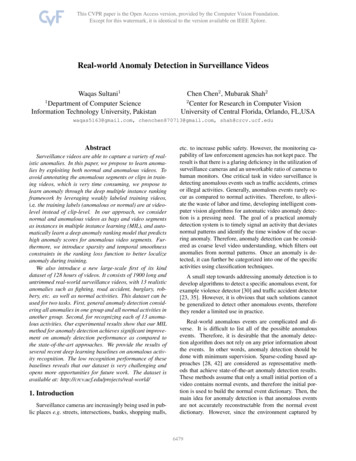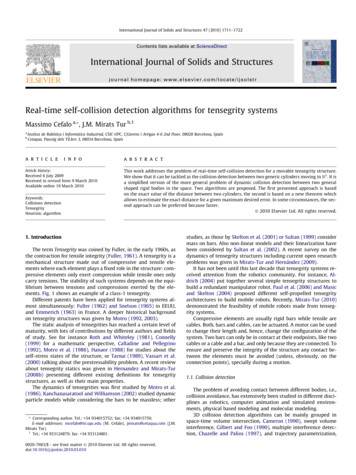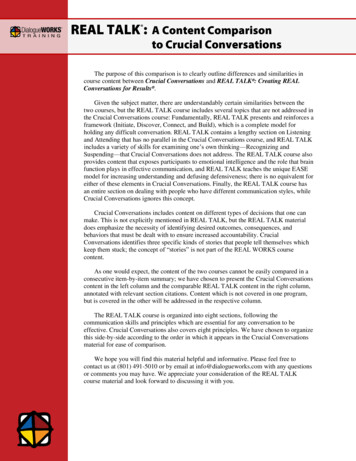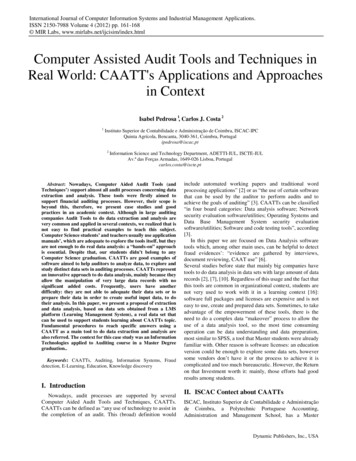
Transcription
Real-world Anomaly Detection in Surveillance VideosWaqas Sultani11Department of Computer ScienceInformation Technology University, PakistanChen Chen2 , Mubarak Shah22Center for Research in Computer VisionUniversity of Central Florida, Orlando, FL,USAwaqas5163@gmail.com, chenchen870713@gmail.com, shah@crcv.ucf.eduAbstractSurveillance videos are able to capture a variety of realistic anomalies. In this paper, we propose to learn anomalies by exploiting both normal and anomalous videos. Toavoid annotating the anomalous segments or clips in training videos, which is very time consuming, we propose tolearn anomaly through the deep multiple instance rankingframework by leveraging weakly labeled training videos,i.e. the training labels (anomalous or normal) are at videolevel instead of clip-level. In our approach, we considernormal and anomalous videos as bags and video segmentsas instances in multiple instance learning (MIL), and automatically learn a deep anomaly ranking model that predictshigh anomaly scores for anomalous video segments. Furthermore, we introduce sparsity and temporal smoothnessconstraints in the ranking loss function to better localizeanomaly during training.We also introduce a new large-scale first of its kinddataset of 128 hours of videos. It consists of 1900 long anduntrimmed real-world surveillance videos, with 13 realisticanomalies such as fighting, road accident, burglary, robbery, etc. as well as normal activities. This dataset can beused for two tasks. First, general anomaly detection considering all anomalies in one group and all normal activities inanother group. Second, for recognizing each of 13 anomalous activities. Our experimental results show that our MILmethod for anomaly detection achieves significant improvement on anomaly detection performance as compared tothe state-of-the-art approaches. We provide the results ofseveral recent deep learning baselines on anomalous activity recognition. The low recognition performance of thesebaselines reveals that our dataset is very challenging andopens more opportunities for future work. The dataset isavailable at: http://crcv.ucf.edu/projects/real-world/1. IntroductionSurveillance cameras are increasingly being used in public places e.g. streets, intersections, banks, shopping malls,etc. to increase public safety. However, the monitoring capability of law enforcement agencies has not kept pace. Theresult is that there is a glaring deficiency in the utilization ofsurveillance cameras and an unworkable ratio of cameras tohuman monitors. One critical task in video surveillance isdetecting anomalous events such as traffic accidents, crimesor illegal activities. Generally, anomalous events rarely occur as compared to normal activities. Therefore, to alleviate the waste of labor and time, developing intelligent computer vision algorithms for automatic video anomaly detection is a pressing need. The goal of a practical anomalydetection system is to timely signal an activity that deviatesnormal patterns and identify the time window of the occurring anomaly. Therefore, anomaly detection can be considered as coarse level video understanding, which filters outanomalies from normal patterns. Once an anomaly is detected, it can further be categorized into one of the specificactivities using classification techniques.A small step towards addressing anomaly detection is todevelop algorithms to detect a specific anomalous event, forexample violence detector [30] and traffic accident detector[23, 35]. However, it is obvious that such solutions cannotbe generalized to detect other anomalous events, thereforethey render a limited use in practice.Real-world anomalous events are complicated and diverse. It is difficult to list all of the possible anomalousevents. Therefore, it is desirable that the anomaly detection algorithm does not rely on any prior information aboutthe events. In other words, anomaly detection should bedone with minimum supervision. Sparse-coding based approaches [28, 42] are considered as representative methods that achieve state-of-the-art anomaly detection results.These methods assume that only a small initial portion of avideo contains normal events, and therefore the initial portion is used to build the normal event dictionary. Then, themain idea for anomaly detection is that anomalous eventsare not accurately reconstructable from the normal eventdictionary. However, since the environment captured by6479
surveillance cameras can change drastically over the time(e.g. at different times of a day), these approaches producehigh false alarm rates for different normal behaviors.Motivation and contributions. Although the abovementioned approaches are appealing, they are based onthe assumption that any pattern that deviates from thelearned normal patterns would be considered as an anomaly.However, this assumption may not hold true because it isvery difficult or impossible to define a normal event whichtakes all possible normal patterns/behaviors into account[9]. More importantly, the boundary between normal andanomalous behaviors is often ambiguous. In addition, under realistic conditions, the same behavior could be a normal or an anomalous behavior under different conditions.In this paper, we propose an anomaly detection algorithmusing weakly labeled training videos. That is we only knowthe video-level labels, i.e. a video is normal or containsanomaly somewhere, but we do not know where. This isintriguing because we can easily annotate a large number ofvideos by only assigning video-level labels. To formulate aweakly-supervised learning approach, we resort to multipleinstance learning (MIL) [12, 4]. Specifically, we propose tolearn anomaly through a deep MIL framework by treatingnormal and anomalous surveillance videos as bags and shortsegments/clips of each video as instances in a bag. Based ontraining videos, we automatically learn an anomaly rankingmodel that predicts high anomaly scores for anomalous segments in a video. During testing, a long-untrimmed video isdivided into segments and fed into our deep network whichassigns anomaly score for each video segment such that ananomaly can be detected. In summary, this paper makes thefollowing contributions. We propose a MIL solution to anomaly detection byleveraging only weakly labeled training videos. We propose a MIL ranking loss with sparsity and smoothness constraints for a deep learning network to learn anomaly scoresfor video segments. We introduce a large-scale video anomaly detectiondataset consisting of 1900 real-world surveillance videos of13 different anomalous events and normal activities captured by surveillance cameras. It is by far the largestdataset with more than 25 times videos than existing largestanomaly dataset and has a total of 128 hours of videos. Experimental results on our new dataset show that ourproposed method achieves superior performance as compared to the state-of-the-art anomaly detection approaches. Our dataset also serves a challenging benchmark foractivity recognition on untrimmed videos, due to the complexity of activities and large intra-class variations. We provide results of baseline methods, C3D [37] and TCNN [21],on recognizing 13 different anomalous activities.2. Related WorkAnomaly detection. Anomaly detection is one of themost challenging and long standing problems in computervision [40, 39, 7, 10, 5, 20, 43, 27, 26, 28, 42, 18, 26]. Forvideo surveillance applications, there are several attemptsto detect violence or aggression [15, 25, 11, 30] in videos.Datta et al. proposed to detect human violence by exploiting motion and limbs orientation of people. Kooij et al. [25]employed video and audio data to detect aggressive actionsin surveillance videos. Gao et al. proposed violent flow descriptors to detect violence in crowd videos. More recently,Mohammadi et al. [30] proposed a new behavior heuristicbased approach to classify violent and non-violent videos.Beyond violent and non-violent patterns discrimination,authors in [39, 7] proposed to use tracking to model the normal motion of people and detect deviation from that normalmotion as an anomaly. Due to difficulties in obtaining reliable tracks, several approaches avoid tracking and learnglobal motion patterns through histogram-based methods[10], topic modeling [20], motion patterns [32], social forcemodels [29], mixtures of dynamic textures model [27], Hidden Markov Model (HMM) on local spatio-temporal volumes [26], and context-driven method [43]. Given the training videos of normal behaviors, these approaches learn distributions of normal motion patterns and detect low probable patterns as anomalies.Following the success of sparse representation and dictionary learning approaches in several computer visionproblems, researchers in [28, 42] used sparse representationto learn the dictionary of normal behaviors. During testing,the patterns which have large reconstruction errors are considered as anomalous behaviors. Due to successful demonstration of deep learning for image classification, several approaches have been proposed for video action classification[24, 37]. However, obtaining annotations for training is difficult and laborious, specifically for videos.Recently, [18, 40] used deep learning based autoencoders to learn the model of normal behaviors and employed reconstruction loss to detect anomalies. Our approach not only considers normal behaviors but also anomalous behaviors for anomaly detection, using only weakly labeled training data.Ranking. Learning to rank is an active research areain machine learning. These approaches mainly focused onimproving relative scores of the items instead of individual scores. Joachims et al. [22] presented rank-SVM toimprove retrieval quality of search engines. Bergeron etal. [8] proposed an algorithm for solving multiple instanceranking problems using successive linear programming anddemonstrated its application in hydrogen abstraction problem in computational chemistry. Recently, deep rankingnetworks have been used in several computer vision applications and have shown state-of-the-art performances. They6480
have been used for feature learning [38], highlight detection[41], Graphics Interchange Format (GIF) generation [17],face detection and verification [33], person re-identification[13], place recognition [6], metric learning and image retrieval [16]. All deep ranking methods require a vast amountof annotations of positive and negative samples.In contrast to the existing methods, we formulateanomaly detection as a regression problem (we call it regression since we map feature vector to an anomaly score(0-1)) in the ranking framework by utilizing normal andanomalous data. To alleviate the difficulty of obtaining precise segment-level labels (i.e. temporal annotations of theanomalous parts in videos) for training, we leverage multiple instance learning which relies on weakly labeled data(i.e. video-level labels – normal or abnormal, which aremuch easier to obtain than temporal annotations) to learnthe anomaly model and detect video segment level anomalyduring testing.3. Proposed Anomaly Detection MethodThe proposed approach (summarized in Figure 1) beginswith dividing surveillance videos into a fixed number ofsegments during training. These segments make instancesin a bag. Using both positive (anomalous) and negative(normal) bags, we train the anomaly detection model usingthe proposed deep MIL ranking loss.3.1. Multiple Instance LearningIn standard supervised classification problems using support vector machine, the labels of all positive and negativeexamples are available and the classifier is learned using thefollowing optimization function:1k} { 11 Xzminmax(0, 1 yi (w.φ(x) b)) kwk2 ,wk i 12(1)where 1 is the hinge loss, yi represents the label of eachexample, φ(x) denotes feature representation of an imagepatch or a video segment, b is a bias, k is the total numberof training examples and w is the classifier to be learned. Tolearn a robust classifier, accurate annotations of positive andnegative examples are needed. In the context of supervisedanomaly detection, a classifier needs temporal annotationsof each segment in videos. However, obtaining temporalannotations for videos is time consuming and laborious.MIL relaxes the assumption of having these accuratetemporal annotations. In MIL, precise temporal locationsof anomalous events in videos are unknown. Instead, onlyvideo-level labels indicating the presence of an anomaly inthe whole video is needed. A video containing anomaliesis labeled as positive and a video without any anomaly islabeled as negative. Then, we represent a positive video asa positive bag Ba , where different temporal segments makeindividual instances in the bag, (p1 , p2 , . . . , pm ), where mis the number of instances in the bag. We assume that atleast one of these instances contains the anomaly. Similarly, the negative video is denoted by a negative bag,Bn , where temporal segments in this bag form negativeinstances (n1 , n2 , . . . , nm ). In the negative bag, none ofthe instances contain an anomaly. Since the exact information (i.e. instance-level label) of the positive instances is unknown, one can optimize the objective function with respectto the maximum scored instance in each bag [4]:minwz11Xmax(0, 1 YBj (max(w.φ(xi )) b)) kwk2 , (2)i Bjz j 12where YBj denotes bag-level label, z is the total number ofbags, and all the other variables are the same as in Eq. 1.3.2. Deep MIL Ranking ModelAnomalous behavior is difficult to define accurately [9],since it is quite subjective and can vary largely from person to person. Further, it is not obvious how to assign 1/0labels to anomalies. Moreover, due to the unavailability ofsufficient examples of anomaly, anomaly detection is usually treated as low likelihood pattern detection instead ofclassification problem [10, 5, 20, 26, 28, 42, 18, 26].In our proposed approach, we pose anomaly detectionas a regression problem. We want the anomalous videosegments to have higher anomaly scores than the normalsegments. The straightforward approach would be to use aranking loss which encourages high scores for anomalousvideo segments as compared to normal segments, such as:f (Va ) f (Vn ),(3)where Va and Vn represent anomalous and normal videosegments, f (Va ) and f (Vn ) represent the correspondingpredicted anomaly scores ranging from 0 to 1, respectively. The above ranking function should work well if thesegment-level annotations are known during training.However, in the absence of video segment level annotations, it is not possible to use Eq. 3. Instead, we propose thefollowing multiple instance ranking objective function:max f (Vai ) max f (Vni ),i Bai Bn(4)where max is taken over all video segments in each bag. Instead of enforcing ranking on every instance of the bag, weenforce ranking only on the two instances having the highest anomaly score respectively in the positive and negativebags. The segment corresponding to the highest anomalyscore in the positive bag is most likely to be the true positiveinstance (anomalous segment). The segment correspondingto the highest anomaly score in the negative bag is the onelooks most similar to an anomalous segment but actually is6481
Positive bagInstance scores in positive bagBag instance (video segment)FC6Pool0.5320.80.11 512 32 temporal segments Conv1a32 temporal segmentsPoolConv2aC3D feature extractionfor each video segmentDropout 60%4096Dropout 60%Dropout 60%0.60.3(anomaly score)0.5pre-trained 3D ConvNet0.30.20.2MIL Ranking Loss with sparsityand smoothness constraintsAnomaly video0.1Normal videoNegative bagInstance scores in negative bagFigure 1. The flow diagram of the proposed anomaly detection approach. Given the positive (containing anomaly somewhere) and negative(containing no anomaly) videos, we divide each of them into multiple temporal video segments. Then, each video is represented as abag and each temporal segment represents an instance in the bag. After extracting C3D features [37] for video segments, we train a fullyconnected neural network by utilizing a novel ranking loss function which computes the ranking loss between the highest scored instances(shown in red) in the positive bag and the negative bag.a normal instance. This negative instance is considered as ahard instance which may generate a false alarm in anomalydetection. By using Eq. 4, we want to push the positive instances and negative instances far apart in terms of anomalyscore. Our ranking loss in the hinge-loss formulation istherefore given as follows:l(Ba , Bn ) max(0, 1 max f (Vai ) max f (Vni )). (5)i Bni BaOne limitation of the above loss is that it ignores the underlying temporal structure of the anomalous video. First, inreal-world scenarios, anomaly often occurs only for a shorttime. In this case, the scores of the instances (segments)in the anomalous bag should be sparse, indicating only afew segments may contain the anomaly. Second, since thevideo is a sequence of segments, the anomaly score shouldvary smoothly between video segments. Therefore, we enforce temporal smoothness between anomaly scores of temporally adjacent video segments by minimizing the difference of scores for adjacent video segments. By incorporating the sparsity and smoothness constraints on the instancescores, the loss function becomesl(Ba , Bn ) max(0, 1 max f (Vai ) max f (Vni ))i Bni Ba λ1z(n 1)Xi1} 2z } {nXf (Vai ),(f (Vai ) f (Vai 1 ))2 λ2{(6)iwhere 1 indicates the temporal smoothness term and 2represents the sparsity term. In this MIL ranking loss, theerror is back-propagated from the maximum scored videosegments in both positive and negative bags. By training ona large number of positive and negative bags, we expect thatthe network will learn a generalized model to predict highscores for anomalous segments in positive bags (see Figure8). Finally, our complete objective function is given byL(W) l(Ba , Bn ) λ3 kWkF ,(7)where W represents model weights.Bags Formations. We divide each video into the equalnumber of non-overlapping temporal segments and usethese video segments as bag instances. Given each videosegment, we extract the 3D convolution features [37]. Weuse this feature representation due to its computational efficiency and the evident capability of capturing appearanceand motion dynamics in video action recognition.4. Dataset4.1. Previous datasetsWe briefly review the existing video anomaly detectiondatasets in this section. The UMN dataset [2] consists offive different staged videos, where people walk around andafter some time start running in different directions. Theanomaly is characterized by only running action. UCSDPed1 and Ped2 datasets [27] contain 70 and 28 surveillancevideos, respectively. Those videos are captured at only onelocation. The anomalies in the videos are simple and do notreflect realistic anomalies in video surveillance, e.g. peoplewalking across a walkway, non pedestrian entities (skater,biker and wheelchair) in the walkways. Avenue dataset [28]consists of 37 videos. Although it contains more anomalies, they are staged and captured at one location. Similar to[27], videos in this dataset are short and some of the anomalies are unrealistic (e.g. throwing paper). Subway Exit andSubway Entrance datasets [3] contain one long surveillance video each. The two videos capture simple anomalies such as walking in the wrong direction and skippingpayment. BOSS [1] dataset is collected from a surveillancecamera mounted in a train. It contains anomalies such as harassment, person with a disease, panic situation, as well as6482
normal videos. All anomalies are performed by actors. Abnormal Crowd [31] introduced a crowd anomaly datasetwhich contains 31 videos with crowded scenes only. Overall, the previous datasets for video anomaly detection aresmall in terms of the number of videos or the length of thevideo. Variations i
video-level labels indicating the presence of an anomaly in the whole video is needed. A video containing anomalies is labeled as positive and a video without any anomaly is labeled as negative. Then, we represent a positive video as a positive bag B a, where different temporal segments make individual instances in the bag, (p1,p2,.,pm), where m











